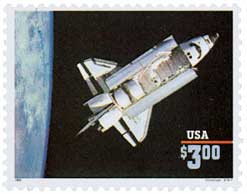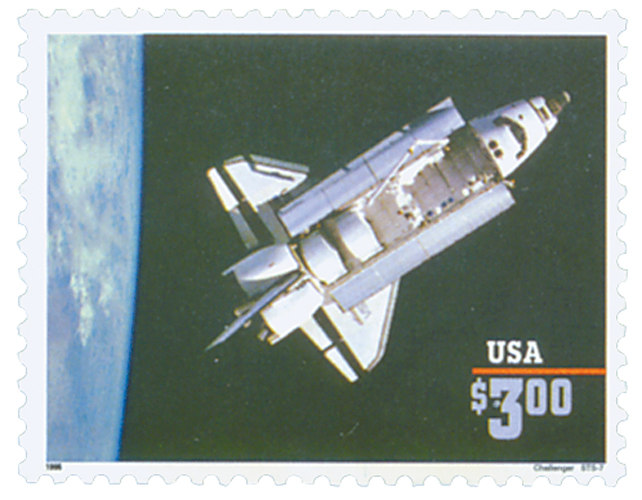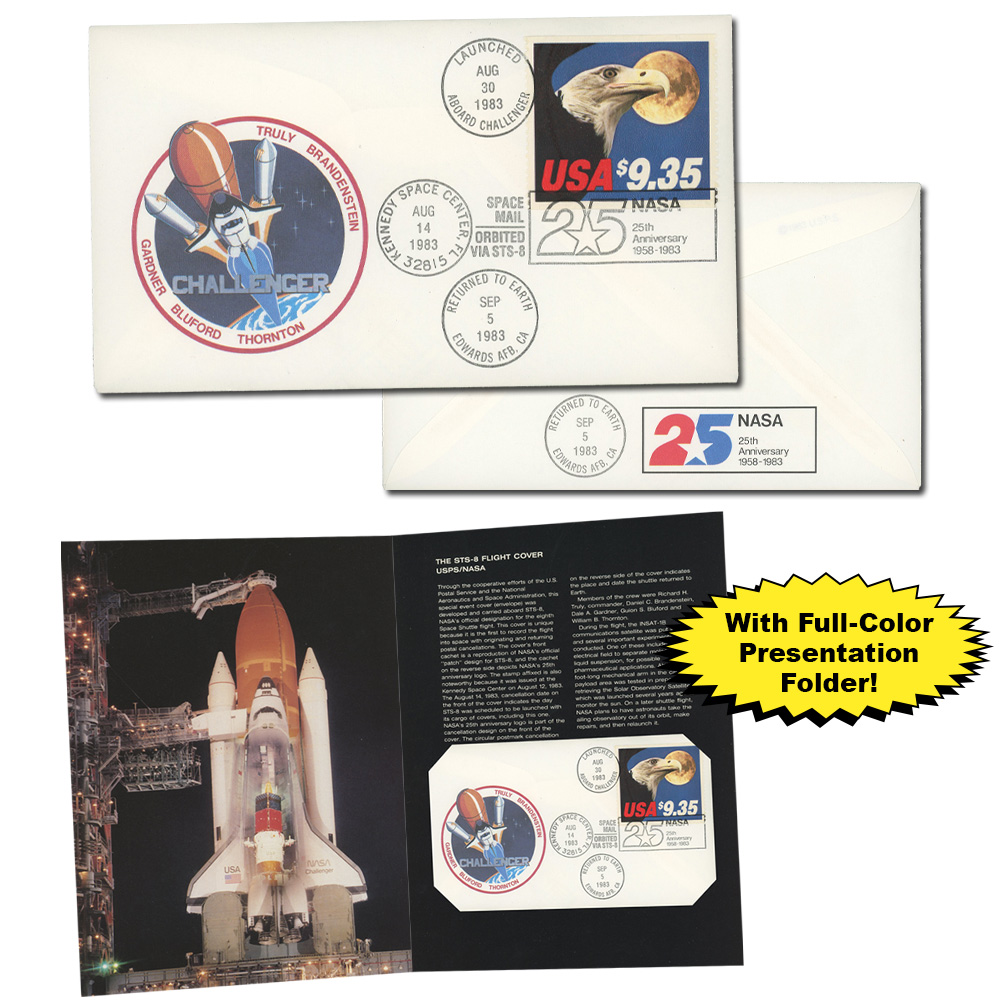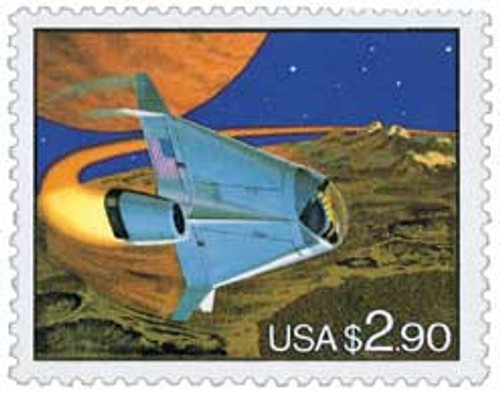
# 2544b - 1996 $3 Space Shuttle 'Challenger', Priority Mail
1995 $3.00 Space Shuttle Challenger
Priority Mail
Issue Date: June 22, 1995
City: Anaheim, California
Quantity: 100,000,000
Printed By: Ashton-Potter
Printing Method: Lithographed, engraved
Perforations: 11.2
Color: Multicolored
Challenger Carries Covers to Space

On August 30, 1983, the space shuttle Challenger blasted off on its third mission to space. The shuttle carried special cargo – commemorative covers bearing the new Express Mail Next Day Service stamp.
The mission, STS-8, was the eighth for the space shuttle program and third for the Challenger. It was originally supposed to launch in July, but was pushed back repeatedly, ultimately launching on August 30. It was the first time a space shuttle took off and landed at night. Guion Bluford Jr., a mission specialist on board, was the first African American in space.

The mission included several goals, including the release of an Indian communications and weather satellite and a variety of scientific experiments. Among the items on board the shuttle were 260,000 covers bearing the new $9.35 Express Mail Next Day Service stamps.

The USPS had offered Express Mail service since the 1970s and introduced next day service in 1978. It was available in more than 3,500 post offices around the country. Small packages weighing less than two pounds were delivered overnight using scheduled airline flights. By 1983, it had reached the number-three spot in air cargo, behind Federal Express but in front of United Parcel Service.

The USPS decided to issue a special stamp for this service to meet escalating demands for overnight letter service, which experts believed was caused by a lack of consumer confidence in first-class mail. The stamp was an improvement on the original service. It could be purchased at any post office and dropped in letterboxes or picked up by mail carriers, making the service accessible to tens of thousands of sites, rather than just the original 3,500.

The Express Mail Next Day stamp was designed by the Postal Service’s advertising agency, Young and Rubicam. They had used the image of an eagle flying in front of the moon for the ad campaign for the Express Mail service. As well as being the national bird of the US, the eagle is a symbol of reliability. The image of the moon used on the stamp was from a photo taken by NASA in 1972. Many consider this stamp one of the most beautiful in modern times.

To increase awareness of the stamp and the overnight service, arrangements were made to fly specially designed covers bearing this stamp on the Challenger. The stamp was issued on August 12, 1983, the scheduled launch day of the space shuttle. The flight was delayed because of technical difficulties, and finally took off on August 30, with the prepared covers securely packed and pressurized in the cargo bay.
The Challenger returned to Earth on September 5, and postal inspectors supervised the unloading of the flown covers. The covers were not damaged despite having flown over 2.5 million miles. The covers had three cancels – a postmark from Kennedy Space Center on August 14, a postmark from the shuttle’s launch on August 30, and a postmark from the shuttle’s return to Earth on September 5 at Edwards Air Force Base, California.

Originally, the stamps were to be sold in booklet panes of three. Each stamp satisfied the rate to mail one small package of up to two pounds. In October 1983, the USPS announced that the stamps could be sold singly for those people who wanted to send one package and did not have a use for the other two stamps. The Postal Service later made the Eagle Express Mail stamp valid for all mail services, making it the costliest postage stamp in US history.
1995 $3.00 Space Shuttle Challenger
Priority Mail
Issue Date: June 22, 1995
City: Anaheim, California
Quantity: 100,000,000
Printed By: Ashton-Potter
Printing Method: Lithographed, engraved
Perforations: 11.2
Color: Multicolored
Challenger Carries Covers to Space

On August 30, 1983, the space shuttle Challenger blasted off on its third mission to space. The shuttle carried special cargo – commemorative covers bearing the new Express Mail Next Day Service stamp.
The mission, STS-8, was the eighth for the space shuttle program and third for the Challenger. It was originally supposed to launch in July, but was pushed back repeatedly, ultimately launching on August 30. It was the first time a space shuttle took off and landed at night. Guion Bluford Jr., a mission specialist on board, was the first African American in space.

The mission included several goals, including the release of an Indian communications and weather satellite and a variety of scientific experiments. Among the items on board the shuttle were 260,000 covers bearing the new $9.35 Express Mail Next Day Service stamps.

The USPS had offered Express Mail service since the 1970s and introduced next day service in 1978. It was available in more than 3,500 post offices around the country. Small packages weighing less than two pounds were delivered overnight using scheduled airline flights. By 1983, it had reached the number-three spot in air cargo, behind Federal Express but in front of United Parcel Service.

The USPS decided to issue a special stamp for this service to meet escalating demands for overnight letter service, which experts believed was caused by a lack of consumer confidence in first-class mail. The stamp was an improvement on the original service. It could be purchased at any post office and dropped in letterboxes or picked up by mail carriers, making the service accessible to tens of thousands of sites, rather than just the original 3,500.

The Express Mail Next Day stamp was designed by the Postal Service’s advertising agency, Young and Rubicam. They had used the image of an eagle flying in front of the moon for the ad campaign for the Express Mail service. As well as being the national bird of the US, the eagle is a symbol of reliability. The image of the moon used on the stamp was from a photo taken by NASA in 1972. Many consider this stamp one of the most beautiful in modern times.

To increase awareness of the stamp and the overnight service, arrangements were made to fly specially designed covers bearing this stamp on the Challenger. The stamp was issued on August 12, 1983, the scheduled launch day of the space shuttle. The flight was delayed because of technical difficulties, and finally took off on August 30, with the prepared covers securely packed and pressurized in the cargo bay.
The Challenger returned to Earth on September 5, and postal inspectors supervised the unloading of the flown covers. The covers were not damaged despite having flown over 2.5 million miles. The covers had three cancels – a postmark from Kennedy Space Center on August 14, a postmark from the shuttle’s launch on August 30, and a postmark from the shuttle’s return to Earth on September 5 at Edwards Air Force Base, California.

Originally, the stamps were to be sold in booklet panes of three. Each stamp satisfied the rate to mail one small package of up to two pounds. In October 1983, the USPS announced that the stamps could be sold singly for those people who wanted to send one package and did not have a use for the other two stamps. The Postal Service later made the Eagle Express Mail stamp valid for all mail services, making it the costliest postage stamp in US history.














